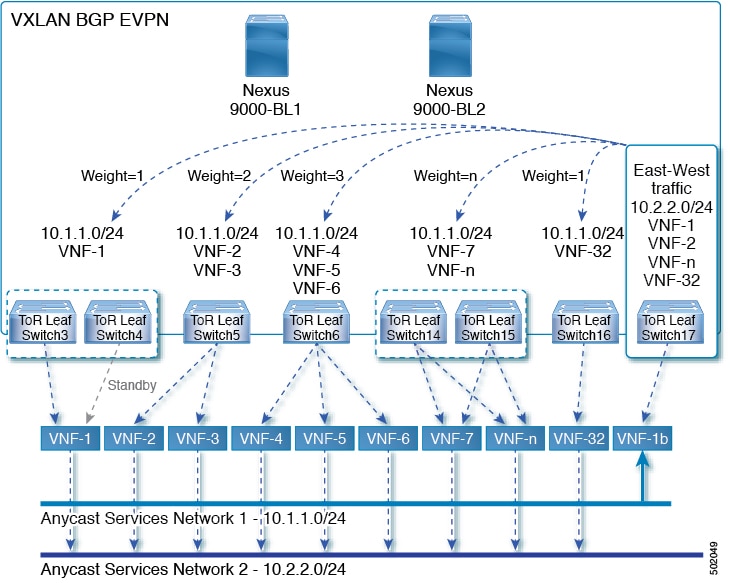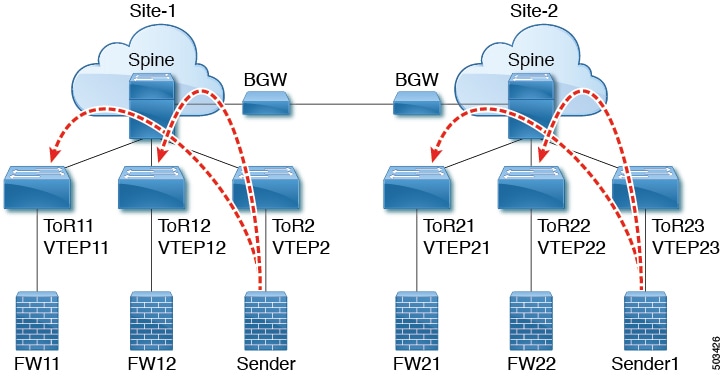Proportional Multipaths for VNF
In Network Function Virtualization Infrastructures (NFVi), anycast services networks are advertised from multiple Virtual Network Functions (VNFs). The Proportional Multipath for VNF feature enables advertising of all the available next hops to a given destination network. This feature enables the switch to consider all paths to a given route as equal cost multipath (ECMP) allowing the traffic to be forwarded using all the available links stretched across multiple ToRs.

In the preceding diagram, North-South traffic that enters the VXLAN fabric at a border leaf is sent across all egress endpoints with the traffic forwarded proportional to the number of links from the egress top of rack (ToR) to the destination network.

East-West traffic is forwarded between the VXLAN Tunnel Endpoints (VTEPs) proportional to the number of next hops advertised by each ToR switch to the destination network.
The switch uses BGP to advertise reachability within the fabric using the Layer 2 VPN (L2VPN)/Ethernet VPN (EVPN) address family. If all ToR switches and border leafs are within the same Autonomous System (AS), a full internal BGP (iBGP) mesh is configured by using route reflectors or by having each BGP router peer with every other router.
Each ToR and border leaf constitutes a VTEP in the VXLAN fabric. You can use a BGP route reflector to reduce the full mesh BGP sessions across the VTEPs to a single BGP session between a VTEP and the route reflector. Virtual Network Identifiers (VNIs) are globally unique within the overlay. Each Virtual Routing and Forwarding (VRF) instance is mapped to a unique VNI. The inner destination MAC address in the VXLAN header belongs to the receiving VTEP that does the routing of the VXLAN payload. This MAC address is distributed as a BGP attribute along with the EVPN routes.
Advertisement of Customer Networks
Customer networks are configured statically or learned locally by using an interior gateway protocol, (IGP) or external BGP (eBGP), over a Provider Edge(PE)-Customer Edge(CE) link. These networks are redistributed into BGP and advertised to the VXLAN fabric.
The networks advertised to the ToRs by the virtual machines (VMs) attached to them are advertised to the VXLAN fabric as EVPN Type-5 routes with the following:
-
The route distinguisher (RD) will be the Layer 3 VNI's configured RD.
-
The gateway IP field will be populated with the next hop.
-
The next hop of the EVPN route will continue to be the VTEP IP.
-
The export route targets of the routes will be derived from the configured export route targets of the associated Layer 3 VNI.
Multiple VRF routes may generate the same Type-5 Network Layer Reachability Information (NLRI) differentiated only by the gateway IP field. The routes are advertised with the L3VNI’s RD, and the gateway IP isn't part of the Type-5 NLRI’s key. The NLRI is exchanged between BGP routers using update messages. These routes are advertised to the EVPN AF by extending the BGP export mechanism to include ECMPs and using the addpath BGP feature in the EVPN AF.
Each Type-5 route within the EVPN AF that is created by using the Proportional Multipath for VNF feature may have multiple paths that are imported into the corresponding VRF based on the matching of the received route targets and by having ECMP enabled within the VRF and in the EVPN AF. Within the VRF, the route is a single prefix with multiple paths. Each path represents a Type-5 EVPN path or those learned locally within the VRF. The EVPN Type-5 routes that are enabled for the Proportional Multipath for VNF feature will have their next hop in the VRF derived from their gateway IP field. Use the export-gateway-ip command to enable BGP to advertise the gateway IP in the EVPN Type-5 routes.
Use the maximum-paths mixed command to enable BGP and the Unicast Routing Information Base (URIB) to consider the following paths as ECMP:
-
iBGP paths
-
eBGP paths
-
Paths from other protocols (such as static) that are redistributed or injected into BGP
The paths can be either local to the device (static, iBGP, or eBGP) or remote (eBGP or iBGP learned over BGP-EVPN). This overrides the default route selection behavior in which local routes are preferred over remote routes. URIB downloads all next hops of the route, including locally learned and user-configured routes, to the Unicast FIB Distribution Module (uFDM)/Forwarding Information Base (FIB).
Beginning with Cisco NX-OS Release 9.3(5), you don't need to use mixed paths. You can choose to have only eBGP or iBGP filter the ECMP paths.
When you enter the maximum-paths mixed command beginning with Cisco NX-OS Release 9.3(5), BGP checks for the AS-path length by default. If you want to ignore the AS-path length (for example, on nodes that participate in packet forwarding such as BGWs and VTEPs), you must enter the bestpath as-path ignore command. When the maximum-paths mixed command is enabled for earlier releases, BGP ignores the AS-path length, and URIB ignores the administrative distance when choosing ECMPs. To ensure that no impact is observed, we recommend upgrading to Cisco NX-OS Release 9.3(5) prior to entering this command.
Use the advertise-gw-ip command to advertise EVPN Type-5 routes with the gateway IP set. ToRs then advertise the gateway IP in the Type-5 NLRI. However, legacy peers running on NX-OS version older than Cisco NX-OS Release 9.2(1) can't process the gateway IP which might lead to unexpected behavior. To prevent this scenario from occurring, use the no advertise-gw-ip command to disable the Proportional Multipath for VNF feature for a legacy peer. BGP sets the gateway IP field of the Type-5 NLRI to zero even if the path being advertised has a valid gateway IP.
The no advertise-gw-ip command flaps the specified peer session as gracefully as possible. The remote peer triggers a graceful restart if the peer supports this capability. When the session is re-established, the local peer advertises EVPN Type-5 routes with the gateway IP set or with the gateway IP as zero depending on whether the advertise-gw-ip command has been used. By default, this knob is enabled and the gateway IP field is populated with the appropriate next hop value.
You can configure next-hop filtering to exclude temporarily silent next-hops, but you should know the subnet IPs, SVI, and interfaces to which the VNF is attached. You can configure next-hop filtering and use this as a safeguard when a VNF does not exist. However, activate the next-hop filtering only when the VNF's IP ARP is resolved.

 Feedback
Feedback